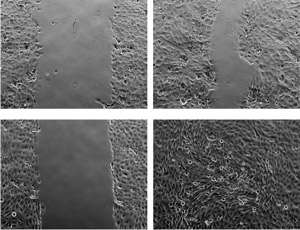Pain receptors in the skin also play an important role in wound healing

A*STAR researchers have found that specialized skin receptors associated with sensing pain also loosen the bonds between cells in skin wounds, enhancing the cells' ability to move into the wound and accelerate the healing process.
These specialized receptors are called 'opioid receptors' because they bind to opioids, a class of painkillers that includes morphine. Identified in the early 1970s, opioid receptors were found to numb pain by binding to neuropeptides, such as endorphins and enkephalins. In the 1990s, Paul Bigliardi and Mei Bigliardi-Qi were the first to discover that these receptors also existed in the outer layer of skin, the epidermis.
Now, Paul Bigliardi and colleagues at the A*STAR Institute of Medical Biology report that opioid receptors in human skin play an important role in influencing cell differentiation, migration and adhesion and are crucial components in the wound-healing process (see image). This link had previously been demonstrated in a mouse model by the delayed healing and thickened wound edge in mice lacking the opioid receptor. This indicated that although skin cells did proliferate, they had problems migrating to the wound bed.
Studies by Bigliardi and his team of the specific pathways and mechanisms involved in the skin opioid receptor system in human cells demonstrated that when the receptors were exposed to opioids, changes occurred in cell-to-cell adhesion and cell migration patterns.
"The most exciting thing is that we can now show that neuropeptides, which are well known in the central nervous system and are involved in pain sensation, are also involved in wound healing," says Bigliardi. This means that pain sensation is probably very important in wound healing and that the nervous system, skin and immune system are closely related, he explains.
The results of this study also have clinical implications. "We can use these principles to affect or control pain and at the same time induce wound healing," says Bigliardi.
Bigliardi's team has patented a product that can be applied topically and are in the process of preparing clinical trials to test it. They expect that the proof of concept for the product will be ready in about 18 months.
The A*STAR-affiliated researchers contributing to this research are from the Institute of Medical Biology. For more information about the team's research, please visit the Experimental Dermatology webpage.
More information: "Activation of the δ-opioid receptor promotes cutaneous wound healing by affecting keratinocyte intercellular adhesion and migration." British Journal of Pharmacology 172, 501–514 (2015). dx.doi.org/10.1111/bph.12687
















